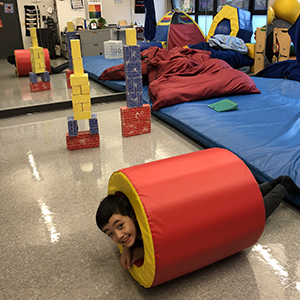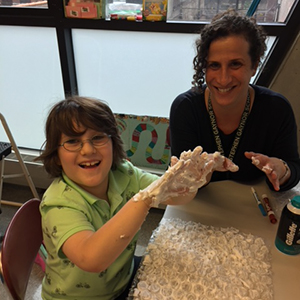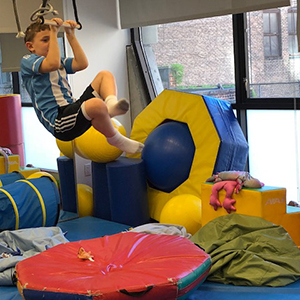By Occupational Therapists Anna Friedman and Ariela Weisenberg
 Most people don’t understand what the word “occupation” has to do with children, who clearly are not in the market for a job. Occupational, within the profession’s title, refers to the occupations or roles that individuals carry out throughout their daily lives. As occupational therapists at Gaynor, we help students become more independent and skilled in their main roles as students and to engage in the world in a meaningful way. We look at the whole child with the overarching goal of improving the quality of functioning.
Most people don’t understand what the word “occupation” has to do with children, who clearly are not in the market for a job. Occupational, within the profession’s title, refers to the occupations or roles that individuals carry out throughout their daily lives. As occupational therapists at Gaynor, we help students become more independent and skilled in their main roles as students and to engage in the world in a meaningful way. We look at the whole child with the overarching goal of improving the quality of functioning.
When working with students, we focus on a wide variety of areas that relate to academic performance as well as social/emotional functioning. These include fine and gross motor skills, activities of daily living, handwriting, perceptual skills, sensory processing, and executive functioning skills.
 There is ongoing teacher collaboration and consultation, to assist with various issues that come up with students in the classroom. A large part of our role with teachers and other specialists is to share and provide tools and strategies to help students maintain a regulated state throughout the school day. This past year, we introduced a Mindfulness program, which includes breathing, movement and meditation. These techniques are being used by teachers as breaks during class and during transitions between periods. In the Early Childhood classes, the therapists are an integral part of the classroom, helping promote skill development within this natural setting. In addition, they pull students individually and in small groups to work in the OT gym, on specific areas.
There is ongoing teacher collaboration and consultation, to assist with various issues that come up with students in the classroom. A large part of our role with teachers and other specialists is to share and provide tools and strategies to help students maintain a regulated state throughout the school day. This past year, we introduced a Mindfulness program, which includes breathing, movement and meditation. These techniques are being used by teachers as breaks during class and during transitions between periods. In the Early Childhood classes, the therapists are an integral part of the classroom, helping promote skill development within this natural setting. In addition, they pull students individually and in small groups to work in the OT gym, on specific areas.
In the Elementary and Middle Schools, individual or dyad sessions are provided via pull out in the OT room or push in to the classroom/school setting. If you took a peek into the OT room, you might likely find a child upside down on a swing or lying on a big therapy ball, working on his/her core muscle strength or sitting at a table practicing letters in shaving cream. Push-in services are an ideal way for us to analyze the relationship between the child, tasks they are presented with and the overall environment. For example, during reading or social studies, we are able to look at a child’s posture, sitting endurance, handwriting, self-regulation, organization, etc. in this functional setting.
 We feel fortunate that kids enjoy coming to the OT room. It is a safe place where skill building occurs, relationships are formed, and confidence and independence are nurtured.
We feel fortunate that kids enjoy coming to the OT room. It is a safe place where skill building occurs, relationships are formed, and confidence and independence are nurtured.
